A visit to Provence can be a sensory overload:
Purple-blue lavender rows combing the landscape
Market stalls brimming with wild mushrooms in a palette of earthy browns
Pincushions of creamy goat cheese
Butcher shop chickens roasted on portable spits on Sunday mornings
Rosé chilling tableside
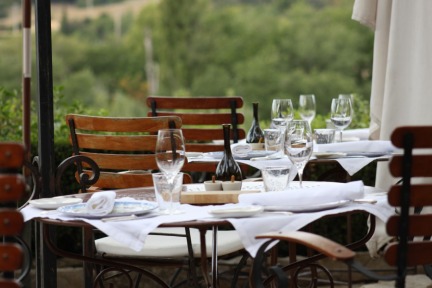
What should I take home from Provence?
Nutmeg often gets asked this question by friends who are visiting Provence, these are five gifts that she would suggest, each one uniquely representative of the region.
Lavender Fuseaux
In the words of French author Jean Giono (1895-1970) “Lavender is the soul of Provence.”
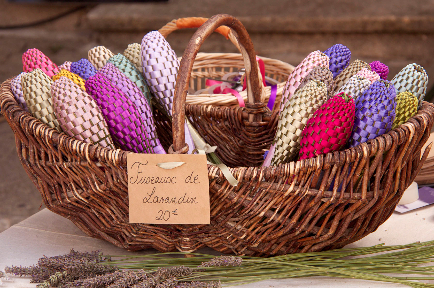
Lavender existed in the wild long before the Romans used it in their baths. Monastery gardens from the Middle Ages included these sensual plants. In the nineteenth century, the perfume industry in Grasse established a consistent demand for the essential oil extracted from lavender.
Shaped like a baby’s rattle the lavender fuseaux are a handmade tradition from the 18th century. The fuseaux a symbol of continued love and future happiness were once given as wedding gifts. One hundred stalks of fresh lavender are bound with bright satin ribbon, the flowers are tucked in the centre and the fabric weaved through the stalks. It takes a full hour to make one fuseaux by hand; unfortunately, there are not many artisans who continue with the tradition.
Elsa Lenthal follows on with this handicraft that her grandmother taught her. You can learn more about her work on her website Fuseaux de Lavande. This is a gift that will last forever.
Fleur de sel
French for the flower of salt an ingredient the foodies on your Christmas list will enjoy. In Provence, there is large-scale production in the Camargue where over 800,000 tons are produced per year. In these commercial operations, seawater is moved into large pans as the water evaporates naturally under sunny rays salt crystals float to the top for a short period of time. These “petals” are gathered manually and packaged for sale. You are able to buy fleur de sel in local markets, but the pricing can often be more favourable in the grocery stores.
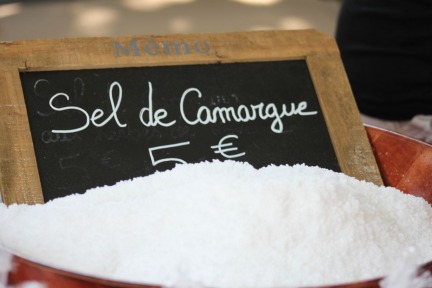
Savon de Marseille
The recipe list for soap is short; oil, sea salt and alkaline ash from sea plants – all readily available near the Mediterranean coast in Provence.
An industry surrounding soap making has existed in the Marseille area since the Middle Ages and still continues today with a finite number of savonneries (soap factories). The ingredients are combined in the correct proportions and heated in large cauldrons for two weeks. The mixture is then transferred to large open pans and allowed to harden. After ten days, the blocks of soap are cut and stamped on six sides, including the weight in grams. Only factories following this ancient methodology have the right to brand their soap with a stamp indicating “Savon de Marseille.” That has been the law since 1688.
Beware of “imposters” in markets and boutiques. The real Savon de Marseille must contain 72% oil (olive, palm or a combination). This soap is 100% biodegradable and friendly for sensitive skin.
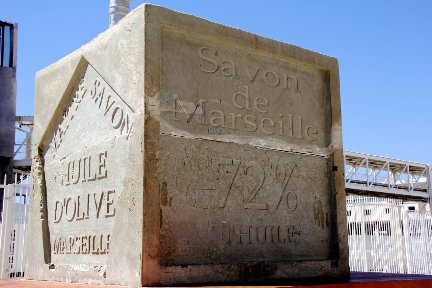
Herbes de Provence
The cook on your Christmas list will thank you for bringing them a gift of herbes de Provence. These dried herb combinations are perfect for a long list of savoury recipes including stews, ratatouille and grilled meat or fish. The herbs are gathered in the wild and dried, then combined. Traditionally each family might have their own particular blend, dependent on individual taste and what herbs grew closest to home. In the 1970s, commercial blends began to appear on store shelves. There is no formal control of what herbs are used in the blends or in what quantities. These are the most common ingredients in the mixtures: rosemary, thyme, oregano, fennel, sage, bay leaf, dill, basil and occasionally lavender (for the tourists). Check the prices in the markets, as it may not always be “bon marché.”
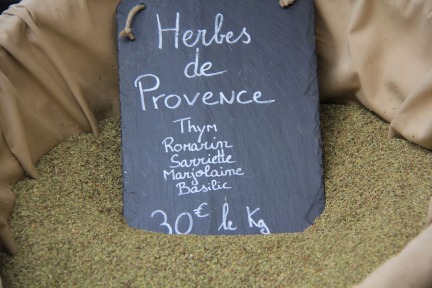
Olive Oil

The Greeks originally planted the ubiquitous Provencal olive tree some 25 centuries ago. There are now over 2000 producers with over 300,000 trees, and that does not include all the trees on personal “plantations.” The olives are harvested in the late fall. This is an opportunity for a festive occasion with friends as the picking process is quicker with a few extra hands. The olives are taken to a local mill, washed and ground into a paste. The paste is then crushed to extra the healthy elixir and bottled.
Merry Christmas!
Food Travel Tags:
fleur de sel, Food, herbes de provence, Lavender, Markets, Olives, Provence, savon de Marseille, Travel Tips











